News
Uma Oya: Benefits begin to flow but key issues not fully addressed
View(s):- Electricity generation underway; paddy lands are being irrigated, but residents say problems persist over water scarcity and compensation payments
By Anthony David from the Uma Oya site. Pix by Indika Handuwala
One of Sri Lanka’s ambitious multipurpose projects aimed at enhancing power generation and irrigating more paddy lands is now ready after weathering many storms in the past 14 years, with even fears of its closure.
During a visit last week, I saw engineers, workers, and officials giving the final finishing touches to the hydropower complex in the scenic village of Karandagolla in the Badulla district. It is the product of grit, determination, and commitment. The complex, surrounded by lush green tea estates, resembles a huge ornament in the middle of a green carpet.

The Uma Oya mulitpurpose project is set to generate 1200MW of electricity and nourish agriculture land in the Badulla and Hambantota districts.
Placed in the project office garden is a replica of the cross-section of the concrete tunnel, a key artery of the project.
Water from the Uma Oya’s tributaries that run through the villages of Puhulpola and Dyrraba is channelled through the underground tunnel to a power station. From there, the water is directed to the Alikota Ara or downstream. The project’s key feature is that it taps Badulla District’s water to generate power, irrigate paddy fields, and eventually channel it to the Hambantota District.
The project was originally funded by Iran’s Export Development Bank and involved a commitment of US$450 million in 2008. The local fund component of the project was a US$79 million. Hardly had the first installment arrived, but Teheran was compelled to halt the project due to United States sanctions. There were fears that the project would be abandoned. However, the Mahinda Rajapaksa government was determined. Hence, it was decided that funds from the Treasury would be utilized, and work would go ahead.
If all goes according to plan, Iran’s President, Ebrahim Raisi, will inaugurate the project. He has shown personal interest whenever Sri Lankan leaders, on visits to Teheran, called on him. His special flight will touch down at the Mattala Mahinda Rajapaksa International Airport. From there, he will fly in a helicopter to the powerhouse site. Interestingly, he would thus have visited the two districts the project covers during the brief visit. If he is unable to visit due to the current tension in the Middle East, a leader who will deputise him will take the same route.
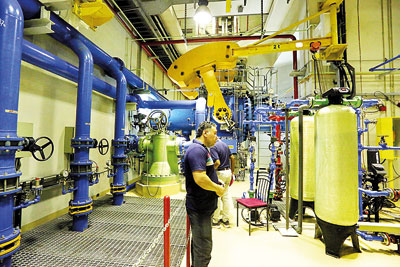
As the project got off the ground, underground delivery of water saw complaints from residents along the route. There were also leaks, which were later attended to. “Water levels are now tightening up. The leak started in 2017. Through a concrete grouting process, the leaks were minimised,” Project Director Engineer D.C.S. Elakanda told the Sunday Times.
“The project has been challenging for a range of reasons,” he said.
The project should have been completed in five years, but it dragged on. However, power generation is now underway, bringing in economic benefits, he said.
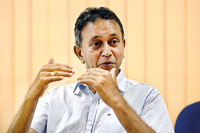
Chief Resident Engineer Priyantha Nanayakkara
The 120 megawatt power station is the project’s main revenue-generating component. Besides, the project is set to irrigate vast acres of land and provide drinking water to many villages.
During the past few weeks alone, Rs 800 million worth of electricity has been generated.
After the issue of funding, the project ran into a crisis with an underground leak in the tunnel and environmental and social problems.
Chief resident engineer Priyantha Nanayakkara, explaining the project, said that one of the key challenges was the leak in the underground tunnel leading to the power station from upstream.
The underground leak was first detected in Bandarawela town.
“The original leak in the tunnel saw water gushing out at a rate of 1,400 litres per second. This was the biggest leak. It was reduced to 300 litres per second through a grouting process. The tunnel was eventually declared stable by geologists and experts. It was stopped there. A mathematical calculation says the leak comes down to 100 litres per second when the tunnel is pressurised. The leak need not be zero. Even the water coming through the leak is eventually used for power generation,” Mr. Nanayakkara explained.
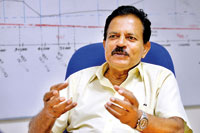
Engineer D.C.S. Elakanda
Incidents of houses cracking up, drinking water wells running dry, and farmlands running short of water were among the issues frequently reported.
The government was forced to relocate residents, provide drinking water, and compensate the affected people.
According to Engineer Elakanda, the issues of compensation payments and the water crisis are being addressed.
“Now water levels are rising,” he said.
He said only 600 families face a water problem, and the project officers are cleaning up and restoring the wells as a solution.
Cracks appearing in the house walls were one of the project’s main challenges. It forced several residents to relocate.
However, Engineer Elakanda said that the issue of compensation is also being addressed.
But, at ground level, not all are happy. Particularly, in Bandarawela and Welimada, residents contest the authorities’ claims over compensation payments. They also dispute the claim that well water levels are rising. 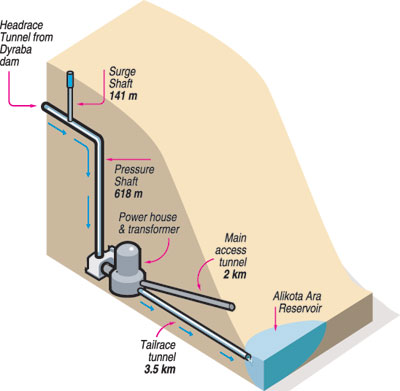
They have also expressed concern about moves to stop the free distribution of drinking water by the end of this month (see box story).
The residents’ battle to claim compensation is not over, with the latest meeting on the issue taking place earlier this month.
“There have been a series of disputes about the manner in whihc compensation has been paid out and how the calculations have been made. It is clear that some people have been favoured over others,” said D.M. Janaka Nilanpriya, a resident whose cut-flower business suffered a loss due to the lack of water.
He said that certain people with political connections and those known to officials have been able to get higher compensation payments. He called for a probe into how the payments have been made.
In Bandarawela, shopkeeper Lalith Wijesundara said that although alternative land had been provided to him, there were issues in occupying the land as it did not have a proper roadway and electricity supplies.
He also said there had been huge discrepancies in providing alternative lands to people.
Hemantha Withanage, founder and executive director of the Centre for Environmental Justice, has filed action over the damages caused by the project. The case has been going on for the past nine years, with various government agencies delaying submitting their reports.
Mr. Withanage believes that some 3,000 families have been affected by the project, and the payment of compensation has been gradually reduced, with people now being paid 20 to 30 percent of the estimated compensation payment.
He said corruption had plagued the compensation payment, thereby causing dissatisfaction among the affected residents.
Affected residents say that since the project is now generating income, the government could expedite measures to resolve the compensation payment issues, especially for those living in the upstream areas.
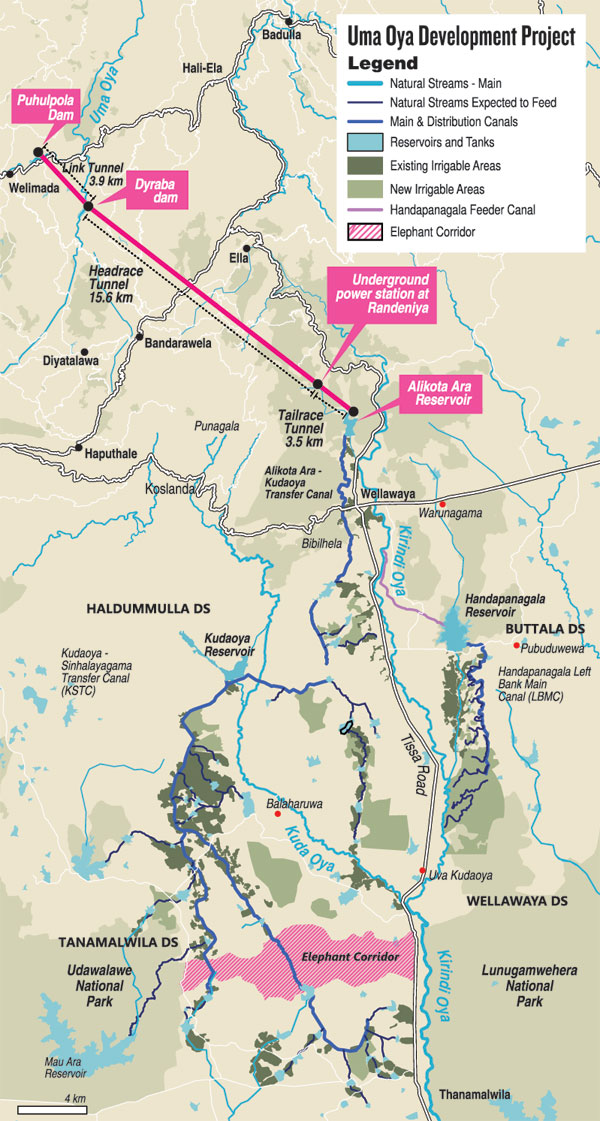
| Farmers now cultivate paddy in both seasons with Uma Oya water The Uma Oya downstream development project, where more than 20,000 acres of existing and new lands would receive water for agricultural purposes, is slowly and steadily becoming a reality. Farming lands that were abandoned in Wellawaya due to water scarcity are now being irrigated, with the water reaching them via the Alikota Ara tank. Under the project, the water from the Alikota Ara tank is channelled through a canal into the Kirindi Oya, from where it reaches the Handapanagala tank and the cultivable lands.  H.H. Kamalawathi: Happy that they have water to grow paddy Among the beneficiaries are those who have received land after being displaced from the Hali Ela and Welimada areas, while others are from Wellawaya itself. “We are now in a position to cultivate paddy lands for both the Yala and Maha seasons instead of cultivating paddy in one season and an alternative crop in the other,” A.N. Siripala, one of the settlers at Theliulla in Wellawaya, said. Those settling in the area have been provided one and a half acres for paddy cultivation and 18 perches to construct a house. “Many people were reluctant to make use of the land allocated to them earlier, but as they witnessed the water coming into the area, people have gained the confidence to cultivate,” he said. H.H. Kamalawathi, who has settled in the area with her husband and son, told the Sunday Times that after several years, they were now receiving water, enabling them to grow paddy instead of depending on Chena cultivation and other crops with limited resources. “I am happy that we have sufficient water and are even able to take a bath from the water we receive,” she said. However, those settled in the area face one common problem: the presence of elephants in the surrounding jungles. To overcome the issue, temporary electric fences powered by a solar system have been erected, but residents fear that with a larger area coming under paddy cultivation, more elephants will be attracted to the area. Settlers said that authorities would have to devise plans to keep the elephants as more people are coming forward to cultivate their lands with the availability of water. Irrigation Department officials have continued with their efforts to dig canals mainly using local labour. Meanwhile, the water flowing in from the Alikota Ara tank flows through Meegas Ara, Kuda Oya, Sinhalayagama, and further south into the Thanamalwila area, filling several tanks and irrigating vast areas. The work of the Uma Oya Downstream Project, which has been undertaken by the Irrigation Department, is continuing with several of the canals yet to be completed but is set to eventually provide water for irrigation and industrial purposes in the Hambantota district. 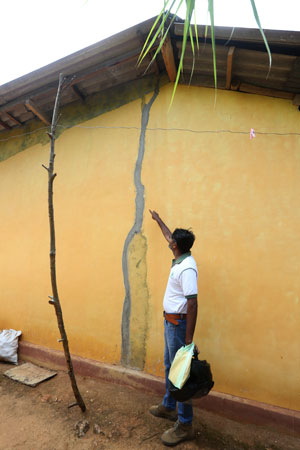 V.A.S. Sajeevana Deshapriya: Collecting data on damages Villagers say problems not over By K.R. Rajamanthri in Welimada As the Uma Oya Multipurpose Development Project enters a new phase of generating hydropower, the woes of some of the villages in Welimada, Bandarawela, and adjoining areas are still not over V.A.S. Sajeevana Deshapriya, secretary of an ad hoc organisation representing the residents affected by the Uma Oya project, says he collects data on the affected persons and the damage caused by the project. “Our immediate fear is that the free distribution of drinking water to the affected areas through bowsers is due to come to an end by the end of the month,” Mr. Deshapiriya said. With the Iranian company FARAB completing the project, its payments for the distribution of water will also come to an end, he said, adding that villagers have been warned that they will not receive water from next month. “In any case, people receive water only once every four days, and that too is limited to 500 litres, which is hardly sufficient for a home,” he said. Commenting on the claims made by officials that the groundwater levels were rising, he said he believes that it was due to recent rains that there has been a rise, but was not sure if it would be consistent. Mr. Deshapriya claimed that paddy farmers in the affected areas were now forced to use the land to grow vegetables. The worries of the villages are not confined only to the water issue but also to the cracks in the houses that continue to appear. Charmari de Silva from the Kirioruwa village said that more cracks have appeared on houses and buildings in the area. A temple in the area was also affected. Another concern among the villagers has been that the land prices in the area have plummeted over the years, and as a result, many of them have not been able to sell their lands at a reasonable price. Our villages have been identified as water-scarce areas and therefore are no longer attractive for people to buy land here, the residents said. Meanwhile, some of the groups that have been campaigning for the rights of those affected have pointed out that the water crisis was predicted as far back as 2008, well before the project started. They have pointed out that some of the warnings had been ignored by the authorities, and proper testing had not been carried out. They said most of the issues could have been minimised if proper testing had been carried out. | |
| Pavithra highlights project’s benefits, urges detractors not to disrupt development Those who will reap the benefits of the Uma Oya Multipurpose Development Project are well aware of its importance, Irrigation Minister Pavithra Wanniarachchi said on Friday after a meeting with various stakeholders of the project. She urged those groups “who are ready to oppose anything” to not stand in the way of development as it was essential for the people. Under the project, water collected at the Puhulpola Reservoir will be transported to the Diaraba Reservoir via a 4 km tunnel. From there, it will be conveyed to two turbines located underground in the Ella Karandagolla area through a 15.5 km tunnel, generating 120 Megawatts of electricity.  Minister Pavithra Wanniarachchi with project officials at the site Once the electricity is generated, the water will be diverted to the Alikota Ara, Handapanagala and Kuda Oya Reservoirs. This water will enable the cultivation of 15,000 acres of farmland during both Yala and Maha cultivation seasons. It will enable the cultivation of a further 30,000 acres of farmland during both seasons in the Lunugamvehera area in the Hambantota District. The minister said the project would nourish the farmlands in the Uva-Wellassa region through the Kirindioya basin, while also fulfilling the drinking water needs of the people of Badulla, Bandarawela and Monaragala Districts. The project is due to be inaugurated on Wednesday (24) jointly by President Ranil Wickremesinghe and visiting Iranian President Ebrahim Raisi. |
Farmers now cultivate paddy in both seasons with Uma Oya water
The Uma Oya downstream development project, where more than 20,000 acres of existing and new lands would receive water for agricultural purposes, is slowly and steadily becoming a reality.
Farming lands that were abandoned in Wellawaya due to water scarcity are now being irrigated, with the water reaching them via the Alikota Ara tank.
Under the project, the water from the Alikota Ara tank is channelled through a canal into the Kirindi Oya, from where it reaches the Handapanagala tank and the cultivable lands.
Among the beneficiaries are those who have received land after being displaced from the Hali Ela and Welimada areas, while others are from Wellawaya itself. “We are now in a position to cultivate paddy lands for both the Yala and Maha seasons instead of cultivating paddy in one season and an alternative crop in the other,” A.N. Siripala, one of the settlers at Theliulla in Wellawaya, said.
Those settling in the area have been provided one and a half acres for paddy cultivation and 18 perches to construct a house.
“Many people were reluctant to make use of the land allocated to them earlier, but as they witnessed the water coming into the area, people have gained the confidence to cultivate,” he said.
H.H. Kamalawathi, who has settled in the area with her husband and son, told the Sunday Times that after several years, they were now receiving water, enabling them to grow paddy instead of depending on Chena cultivation and other crops with limited resources.
“I am happy that we have sufficient water and are even able to take a bath from the water we receive,” she said.
However, those settled in the area face one common problem: the presence of elephants in the surrounding jungles.
To overcome the issue, temporary electric fences powered by a solar system have been erected, but residents fear that with a larger area coming under paddy cultivation, more elephants will be attracted to the area.
Settlers said that authorities would have to devise plans to keep the elephants as more people are coming forward to cultivate their lands with the availability of water.
Irrigation Department officials have continued with their efforts to dig canals mainly using local labour. Meanwhile, the water flowing in from the Alikota Ara tank flows through Meegas Ara, Kuda Oya, Sinhalayagama, and further south into the Thanamalwila area, filling several tanks and irrigating vast areas.
The work of the Uma Oya Downstream Project, which has been undertaken by the Irrigation Department, is continuing with several of the canals yet to be completed but is set to eventually provide water for irrigation and industrial purposes in the Hambantota district.
The best way to say that you found the home of your dreams is by finding it on Hitad.lk. We have listings for apartments for sale or rent in Sri Lanka, no matter what locale you're looking for! Whether you live in Colombo, Galle, Kandy, Matara, Jaffna and more - we've got them all!

